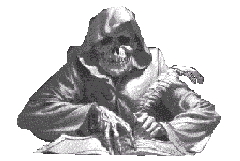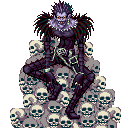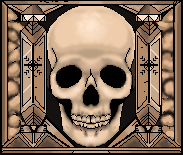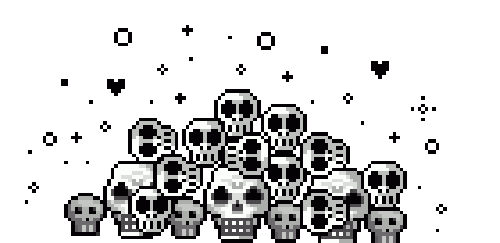Introduction
Since humanity started telling stories, we've personified death in some way. Death is a natural process, and it happens to everything that is alive. It's not something scary - rather, it's something normal, something truly universal.
This page seeks to count as many of these personifications as possible, from ancient gods and goddesses to modern reapers and psychopomps. While death is simply a fact of life, Death is far more interesting as a character and as a metaphor.
Content warnings: discussions of death of all kinds, including murder, suicide, illness, and accidents.

Table of Contents



Classic Depictions
![]() Mictēcacihuātl, San La Muerte, and Depictions of Death in Mexico and Central and South America
Mictēcacihuātl, San La Muerte, and Depictions of Death in Mexico and Central and South America
![]() Shinigami: Death in Japanese Myth and Media
Shinigami: Death in Japanese Myth and Media
![]() A Beginner's Guide to Psychopomps
A Beginner's Guide to Psychopomps
Greek and Roman Pantheons
LinksThanatos |
Greece had several personifications of Death, the most famous being Thanatos. A few others exist, including Ker, the Keres, Styx, Moros, Charon, and Hades, though the latter two aren't Death. Thanatos is specifically the god of a peaceful death, famous for showing up in the myth of Sisyphus, that fella with the rock. In that myth, Thanatos is tricked by Sisyphus into being locked in a box. During that time, no one can die. This is a common trope in stories involving gods - "What if this natural occurrence suddenly stopped happening?" Usually it's reserved for the Sun disappearing or the seasons refusing to change, but Thanatos was one of the first times we asked that question regarding dying. Thanatos also shows up in the Christian mythos, playing the role of the Fourth Horseman on his pale horse. He's given rule over a quarter of the world, and ordered to "kill all upon the Roman earth." This is likely a reference to the Crisis of the Third Century, which was just about to happen.
Charon and Hades are members of the Underworld, but not Death. Charon is a psychopomp in a very literal sense, in that he sails the dead in his ferry across the river Styx in exchange for payment. He is quite literally a guide of the souls. Hades, despite popular depictions, is not "Greek Mythology Satan". He isn't Death, and he isn't evil. Rather, he is the Lord of the Underworld, the king with an eternally expanding kingdom.
Ker, on the opposite end, is the goddess of violent death. The Keres are female spirits of violent dead, and according to Hesiod, they were all born of Nyx (Theogony) and haunted battlefields, feasting on the dead (Shield of Heracles).
As a colony of Greece, Rome took some ideas from it, and eventually created their own Death (with blackjack! and hookers!). They LOVED their syncretism, and renamed Greek entities with Roman ones. In their case, they had Mors, nee Thanatos; and Morta, who is likely Atropos, the Fate sister of the inevitable. Mors is an interesting case: While the god is depicted as male, the word his name comes from, mors is distinctly feminine. This means that Mors is visually male, but linguistically female. This likely led to the ideas of a female death in parts of the world with languages influenced by Latin, especially Latin America.
Mictēcacihuātl, San La Muerte, and Depictions of Death in Mexico and Central and South America
Links |
A few of the most iconic depictions of Death that come from the Americas! Mictēcacihuātl, or "The Lady of the Dead" is the ruler of the Aztec underworld. Her job was to watch over the bones of the deceased, and she appears in the story of the many suns. Her male counterpart was Mictlāntēcutli. The final round of sun creation involved Quetzalcoatl waltzing on down to her realm, Mictlān, and taking the bones of humans to save himself the time of making new ones.
Santa Muerte is one of, if not THE most popular saints worshipped in Latin America. She is derived from Mictēcacihuātl, syncretized with the Virgin Mary, because it turns out the Spaniards were really bad at stamping out the local religion. Her cult is around 10 million strong, bolstered even further by the COVID-19 pandemic.
La Calavera Catrina is an etching by José Guadalupe Posada, originally depicting a satire of wealthy women under the Porfiriato. After Diego Rivera's interpretation, she became a symbol of death and absorbed into the greater cultural idea regarding Día de los Muertos. She is also sometimes depicted with a male counterpart, usually inspired by Posada's satire of wealthy men!
Meanwhile, in Brazil and Argentina, San La Muerte is the name of the game. He's a skeleton with a scythe - familiar imagery to North Americans with the Grim Reaper. Unlike Santa Muerte, he is explicitly part of Catholicism,  and is worshipped as a saint. The Church explicitly denies him, however, since a saint whose whole schtick is death is kinda antithetical to Christ's resurrection. But, hey, what can you do?
and is worshipped as a saint. The Church explicitly denies him, however, since a saint whose whole schtick is death is kinda antithetical to Christ's resurrection. But, hey, what can you do?
The Americas have a love depictions of Death. Guatemala has San Pascualito, who has a church in Olintepeque; the Inca have Supay and Vichama, the former of which has become a Devil-like figure; Bolivia has El Tío; and there are several others who haven't had a paragraph of their own. The several Maya death gods, two of which show up in the Popol Vuh, for instance. We haven't even touched the depictions by Native North Americans yet! (I'll add those eventually!)
In modern animation, this style of depicting Death is VERY popular. The Book of Life is my personal favorite, capturing the detail and opulence of the Calavera herself in La Muerte. Grim from The Grim Adventures of Billy and Mandy is another excellent example. Male skeletal Death gets his own category, though - The Grim Reaper has far too much to cover.
Shinigami: Death in Japanese Myth and Media

These Deaths come from Japan, and have a million forms and formats. Their name literally translates to "kami (god) of death". The idea of Death as a god has been around for centuries, such as Yama, Mrtyu-mara, and the oni Gozu and Mezu. In Shinto, there's some argument about shinigami - some see Izanami, the creator goddess, as Death, due to her giving it to humanity. Death gods also appeared in bunraku theater, usually in stories of murder-suicide. In literature, shinigami were spirits that would possess people and cause them to do acts of evil. These previous shinigami are pre-WWII, though, and after the war, the Western concept of the Grim Reaper influenced the culture. Shinigami became popular choices for characters in manga and anime as a result. They became minor gods of death - in a sense, Death was a title, an occupation.
Famously, Death Note has the shinigami Ryuk; but shinigami show up more often than you'd expect. Soul Eater has Lord Death in the English dub, whose students slay evil beings to create weapons for him; Bleach has Soul Reapers; YuYu Hakusho has Botan; and they're showing up more and more often. Angels of Death, Castlevania's anime adaptation, Death Parade, Black Butler, The Gregory Horror Show (Death is Swedish in that one), and more.
Due to the vast scale of manga that get anime adaptations, this section will only show shinigami that are called shinigami in-text. If they're referred to as anything else (their name, Death, the Reaper, etc) in translation, they'll be placed into the Death in Comics and Manga category. Original anime will be placed here, since their manga adaptations came after their broadcasts.
Further examples: Madoka Kaname (Puella Magi Madoka Magica, though this can be argued as part of her duties as God)
A Beginner's Guide to Psychopomps
This is a Greek word, literally translating to "guide of the souls". These characters are not always explicitly Death, but are guides to the dead, leading them to what's next. 'What's next' varies with culture - sometimes it's an afterlife or punishment, sometimes it's the void, sometimes it's reincarnation. They sometimes guide dreams as well!
Shamans also act as psychopomps in several cultures, guiding souls not only to death, but to birth as well. This has led to the term "death midwife", which caused controversy in hospice and end-of-life circles, as birth midwives didn't particularly like that association.1 These people provide support for the bereaved, including counseling, creating death plans, and dealing with the infamously predatory funeral industry (no, your mom doesn't need a concrete-lined coffin that's $8,000 USD).
This list of psychopomps will be updated occasionally as more are found. This list is for religious, mythological, and folkloric examples only - no modern fiction. You can also consider this as a running list of future entries here!
Hermes (Ancient Greek), Charon (Ancient Greek), Xolotl (Aztec), Yama (Hinduism), Tarakeshvara (Hinduism), Samael (Talmudic Judaism), Daena (Zoroastrianism), Amokye (Akom), Maman Brigitte (Vodou), Jesus Christ (Protestant Christianity), Saint Peter (Catholic Christianity)
Modern Depictions
![]() Playing with Death: Toys and Figurines
Playing with Death: Toys and Figurines
Death in Video Games
Links |
Video games are no strangers to Death showing up. Usually, the character is an antagonist, an enemy to defeat to progress the game. Other times, however, Death is a part of the world, part of the code itself, or the protagonist.
Death as an enemy to defeat isn't stuck to a single genre. Hack-and-slash games like Dante's Inferno have Death as an enemy to defeat. The Touhou Project bullet hell series has Komachi Onozuka, a shinigami and psychopomp that acts as an enemy and player character. Death is also the player character in Darksiders II, and the damsel in Death's Door. Stella of Spiritfarer plays the role of Death and Charon, helping souls overcome their hangups so they can pass on.
In some games, Death shows up not as an antagonist, but as a simple fact of the world. In The Sims, Death shows up as the game's way of clearing out the dead. In League of Legends, Kindred plays the role, as the twin faces of Death - one emotional, one rational. In the world of Pokémon, Death is personified in multiple legendary Pokémon, including Yveltal (destruction), Darkrai (darkness), and Giratina (rules over an alternate, horrifying dimension: The Distortion World); though no one true Death has emerged.
Any further appearances of Death in video games will be listed here with their games in parentheses.
Manny Calavera (Grim Fandango), Death and Death Jr./D.J. (Death Jr.), Thanatos (Hades), Uncle Death (Let it Die), The Grim Reaper (RuneScape), The Reapers (The World Ends with You), The Grim Reaper (The Wonderful 101), Death (Fate), Canus Espada (Cafe Enchante), Gregg (Conker's Bad Fur Day), The Grim Reaper (Bomber Man), Malthael (Diablo)
Death in Music
The arts have a fascination with Death, and music is no exception. The subgenre of death metal is not named after the character, but is argued by scholars between being a reference to a high school assignment by Possessed's bassist Jeff Becerra and a magazine with the genre's name. Death shows up often in music, and this section will be a list of songs that feature the character. Not album covers, as those can be argued to be anyone from politicians to mascots (ex. Eddie the Head of Iron Maiden). Sometimes the boney old bastard is a character, sometimes an abstract concept, sometimes the singer, but always a jam.
Don't Fear the Reaper (Blue Öyster Cult), I Know the Reaper (Machinae Supremacy), I've Got Some Falling to Do (Lemon Demon), I'll Be Haunting You (They Might Be Giants, music video)
Death in Comics and Manga
Sequential art has depicted Death several times, sometimes as a protagonist, other times as a character in the world. This section seeks to list as many as possible.
Some of my personal favorites include The Reaper in the short manga Thirty and a Half Minutes by Snippy MJ, which broke me emotionally; and Death in Pinky and Pepper Forever, which spoke to my sensibilities as an artist. I also recommend Loving Reaper by Jenny-Jinya. Read them all!
Death (Marvel Comics), Death (Detective Comics), Death (The Sandman), The Grim Reaper (Chick Tracts), Angel (Chainsaw Man), The Arbiters (Death Parade), Dominikov (Murder Princess), Zarame (Zombie-Loan), The Black Dog (Beasts of Burden), The Grim Reaper (The Far Side), Death (Slightly Damned)
Death in Media for Children
Kids like death and gross things. It's a fact - girls play in the mud and boys find weird bugs. It's as old as "ring around the rosie", which is famously about the Black Plague. In modern media, especially film and television, Death shows up frequently. Let's run through a few examples, why don't we?
 Death (Horrible Histories): In the edutainment show Horrible Histories, Death runs the skit segment "Stupid Deaths." This part would talk about silly ways people died throughout history, ranging from great heroes dying of infected wounds to stuntmen taking their committment too far.
Death (Horrible Histories): In the edutainment show Horrible Histories, Death runs the skit segment "Stupid Deaths." This part would talk about silly ways people died throughout history, ranging from great heroes dying of infected wounds to stuntmen taking their committment too far.
 Death (Neopets): Revealed in 2013 during the War for the Obelisk event. Death is a cupidlike figure, a baby Ixi with a bow and arrow in a diaper. He was initially a boss in the Battledome, and was retired when the event ended. Apparently, he is the worst fear of the Awakened faction, a group of the undead.
Death (Neopets): Revealed in 2013 during the War for the Obelisk event. Death is a cupidlike figure, a baby Ixi with a bow and arrow in a diaper. He was initially a boss in the Battledome, and was retired when the event ended. Apparently, he is the worst fear of the Awakened faction, a group of the undead.
 Death (Puss in Boots: The Last Wish): Death in this film is an antagonist, and not one seen often in media in general. He wants to take Puss's final life, because he did not value his last eight. Puss does not defeat Death, as no one truly can, but he accepts that his true and final end is inevitable, and learns to value the people with him while he is alive. Sorta getting the jump-start on accepting one's mortality, but I accepted it as young as seventeen, so I say the younger the better. Makes it easier to accept when it inevitably hits you, y'know?
Death (Puss in Boots: The Last Wish): Death in this film is an antagonist, and not one seen often in media in general. He wants to take Puss's final life, because he did not value his last eight. Puss does not defeat Death, as no one truly can, but he accepts that his true and final end is inevitable, and learns to value the people with him while he is alive. Sorta getting the jump-start on accepting one's mortality, but I accepted it as young as seventeen, so I say the younger the better. Makes it easier to accept when it inevitably hits you, y'know?
 Grim: The Grim Reaper in The Grim Adventures of Billy and Mandy. He's Jamaican, he's hilarious, he's friends with Dracula, and if you're from the U.S., you probably saw him nearly get eaten by a weirdly hot Spider Queen every Halloween.
Grim: The Grim Reaper in The Grim Adventures of Billy and Mandy. He's Jamaican, he's hilarious, he's friends with Dracula, and if you're from the U.S., you probably saw him nearly get eaten by a weirdly hot Spider Queen every Halloween.
 G.R.: The most recent example on this list! G.R, short for Grim Reaper, is the cause of the conflict of Pretty Freekin Scary, a show that airs on Disney Channel. She accidentally takes Frankie Ripp instead of Theodore Snickering, the main antagonist.
G.R.: The most recent example on this list! G.R, short for Grim Reaper, is the cause of the conflict of Pretty Freekin Scary, a show that airs on Disney Channel. She accidentally takes Frankie Ripp instead of Theodore Snickering, the main antagonist.
 Lady MacDeath: The personification of Death in the Brazilian comic Turma do Penadinho. She doesn't use the blade of her scythe - rather, she bonks people on the head to take their soul to Purgatory.
Lady MacDeath: The personification of Death in the Brazilian comic Turma do Penadinho. She doesn't use the blade of her scythe - rather, she bonks people on the head to take their soul to Purgatory.
 Reapers (Monster High): There's multiple depictions of Death in the Mattel doll franchise Monster High. D'eath and G. Reaper are both the guidance counselor at Monster High, though the former is book-exclusive and the latter is cartoon-exclusive. They're likely the same character, considering how even Mattel has confused them on occasion. River Styxx is the daughter of the Grim Reaper, and due to her being in training, she's only allowed to have a staff. Her diary implies that Death in this world is not a job title or one singular person, but her family. Her father is the Reaper, she has an uncle Charon, and her father's cousin was banished to the real world for breaking the rules (implied to be D'eath or G. Reaper). In the case of Monster High, Death could be the family business that River Styxx will inherit, but this is contradicted in-text. According to her diary, there's a reaper convention in Las Plague-as.
Reapers (Monster High): There's multiple depictions of Death in the Mattel doll franchise Monster High. D'eath and G. Reaper are both the guidance counselor at Monster High, though the former is book-exclusive and the latter is cartoon-exclusive. They're likely the same character, considering how even Mattel has confused them on occasion. River Styxx is the daughter of the Grim Reaper, and due to her being in training, she's only allowed to have a staff. Her diary implies that Death in this world is not a job title or one singular person, but her family. Her father is the Reaper, she has an uncle Charon, and her father's cousin was banished to the real world for breaking the rules (implied to be D'eath or G. Reaper). In the case of Monster High, Death could be the family business that River Styxx will inherit, but this is contradicted in-text. According to her diary, there's a reaper convention in Las Plague-as.
 The Grim Reaper (Animaniacs): He challenges the Warners to a game of checkers, since they don't know how to play chess. He's also Swedish in this one, bringing our "Death has a chance of seeing the Gavle Goat in person" count to two.
The Grim Reaper (Animaniacs): He challenges the Warners to a game of checkers, since they don't know how to play chess. He's also Swedish in this one, bringing our "Death has a chance of seeing the Gavle Goat in person" count to two.
Playing with Death: Toys and Figurines
Toys, figurines, plushies, and other play items are no strangers to depictions of Death. Usually they're Reaper toys, but other times they're specific characters that represent Death. Some of them have been covered in the Death in Media for Children section, and won't be listed here.
My personal favorite is the Reaper by Squishable, available in Standard, Mini, Snacker, and Micro (with tie-dye alts of the Standard, Mini, and Micro). The little fella also has a sticker, an enamel pin, and a backpack. I have the mini version! (Full disclosure: I'm not paid by Squishable. I just love this little fella.)
There is also the infinitely inferior Otto from Squishmallow, who is manufactured by a bunch of bastards that fund the genocide of Palestinians. Fuck Squishmallow.
More toys to come!
Wikis and Further Reading
It's very likely that these pages will spawn new sections! Check back soon!
TV Tropes: Death and the Maiden, The Problem with Fighting Death, Chess with Death, Don't Fear the Reaper



Coming Soon
Danse Macabre, Death and the Maiden, and Memento Mori: Death in the Fine Arts
Life Replacement Narratives: Death in Korea
Davy Jones's Locker: Death as Told by Sailors
Terry Pratchett's Death
The Muppets' Death
The Grim Reaper
The Angel of Death: Depictions in Abrahamic Religion
Digital Reaping: Death in Fanfiction, Memes, and the Internet Age
Curtain Calls: Death in Live Theater and Performing Arts
Further information about Death in Africa, Asia, Oceania, The Middle East, and Eastern Europe

credits
font: CAT Franken-Deustch by Peter Wiegelheader + various graphics: sushi-pixels, ggengine, horrorgifs
charon: this lantern
dividers: Donna de Leeuw, aka moonpixels
notifiers: Whimsical
cursors: skeleton hand unknown, searching for source. scythe from zaqovt.
the grim reader: unknown, has been used online since 2008. still searching for the source.
sources
cited in chicago author-date style.1. Britten, Liam. 2016. "B.C. College of Midwives demands 'death midwives' stop using title." CBC, 5 July 2016. https://www.cbc.ca/news/canada/british-columbia/college-of-midwives-death-midwives-1.3666406.
Guthke, Karl S. 1999. The Gender of Death: A Cultural History in Art and Literature. Cambridge University Press. [Link]
Card, Lorin and Freeda Wilson. 2009. DEATH-DEFINING PERSONIFICATIONS: THE GRIM REAPER VS. LA GRANDE FAUCHEUSE. University of Toronto. [Link]
With assistance from: TV Tropes, Wikipedia, and various fandom wikis.








.gif)
.gif)
.gif)




